Azure Files and Azure File Sync provide two main types of endpoints for accessing Azure file shares:
- Public endpoints, which have a public IP address and can be accessed from anywhere in the world.
- Private endpoints, which exist within a virtual network and have a private IP address from within the address space of that virtual network.
For both Azure Files and Azure File Sync, the Azure management objects (the storage account and the Storage Sync Service) control both the public and private endpoints. The storage account is a management construct that represents a shared pool of storage in which you can deploy multiple file shares, as well as other storage resources, such as blobs or queues. The Storage Sync Service is a management construct that represents registered servers, which are Windows file servers with an established trust relationship with Azure File Sync, and sync groups, which define the topology of the sync relationship.
This article focuses on how to configure the networking endpoints for both Azure Files and Azure File Sync. To learn more about how to configure networking endpoints for accessing Azure file shares directly, rather than caching on-premises with Azure File Sync, see Configuring Azure Files network endpoints.
We recommend reading Azure File Sync networking considerations prior to reading this how-to guide.
Prerequisites
This article assumes that:
- You have an Azure subscription. If you don't already have a subscription, then create a trial account before you begin.
- You've already created an Azure file share in a storage account which you would like to connect to from on-premises. To learn how to create an Azure file share, see Create an Azure file share.
- You allow domain traffic to the following endpoints, see Azure service endpoints:
Additionally:
Create the private endpoints
When you create a private endpoint for an Azure resource, the following resources are deployed:
- A private endpoint: An Azure resource representing either the private endpoint for the storage account or the Storage Sync Service. Think of this as a resource that connects your Azure resource and a network interface.
- A network interface (NIC): The network interface that maintains a private IP address within the specified virtual network/subnet. This is the exact same resource that gets deployed when you deploy a virtual machine (VM), however instead of being assigned to a VM, it's owned by the private endpoint.
- A private DNS zone: If you've never deployed a private endpoint for this virtual network before, a new private DNS zone will be deployed for your virtual network. A DNS A record will also be created for Azure resource in this DNS zone. If you've already deployed a private endpoint in this virtual network, a new A record for Azure resource will be added to the existing DNS zone. Deploying a DNS zone is optional, however highly recommended to simplify the DNS management required.
Create the storage account private endpoint
Navigate to the storage account for which you would like to create a private endpoint. From the service menu, under Security + networking, select Networking, Private endpoint connections, and then + Private endpoint to create a new private endpoint.
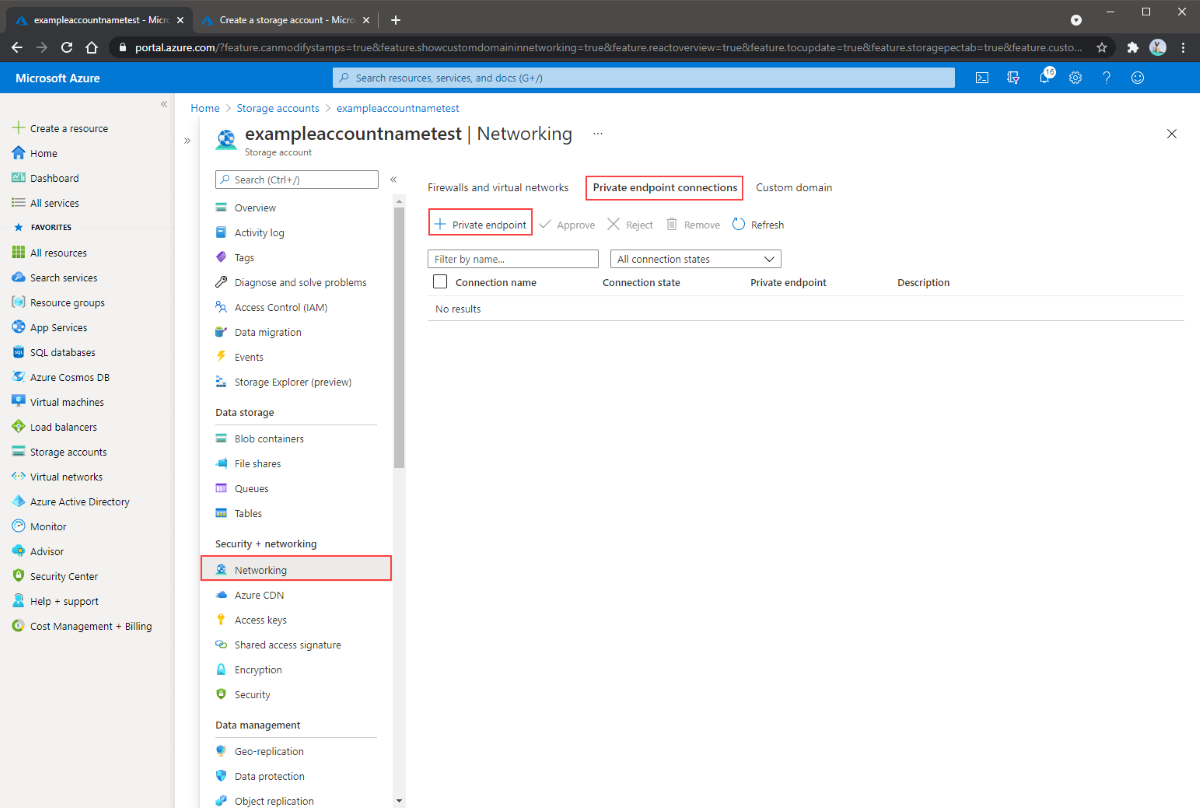
The resulting wizard has multiple pages to complete.
In the Basics blade, select the desired subscription, resource group, name, and region for your private endpoint. These can be whatever you want, they don't have to match the storage account in any way, although you must create the private endpoint in the same region as the virtual network you wish to create the private endpoint in. Then select Next: Resource.
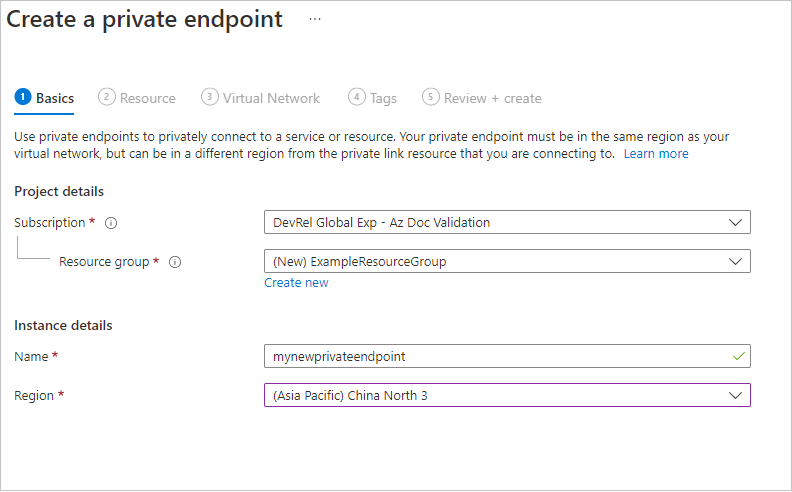
In the Resource blade, select file for the target sub-resource. Then select Next: Virtual Network.
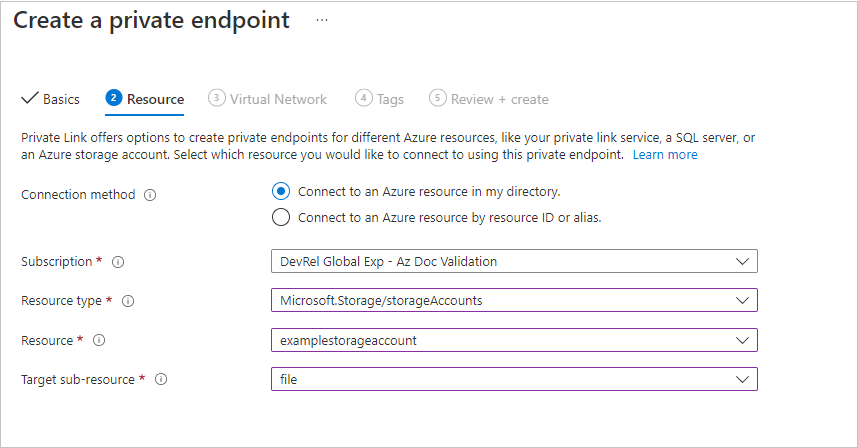
The Virtual Network blade allows you to select the specific virtual network and subnet you would like to add your private endpoint to. Select dynamic or static IP address allocation for the new private endpoint. If you select static, you'll also need to provide a name and a private IP address. The DNS section contains the information for integrating your private endpoint with a private DNS zone. Make sure the subscription and resource group are correct, then select Next: Tags.
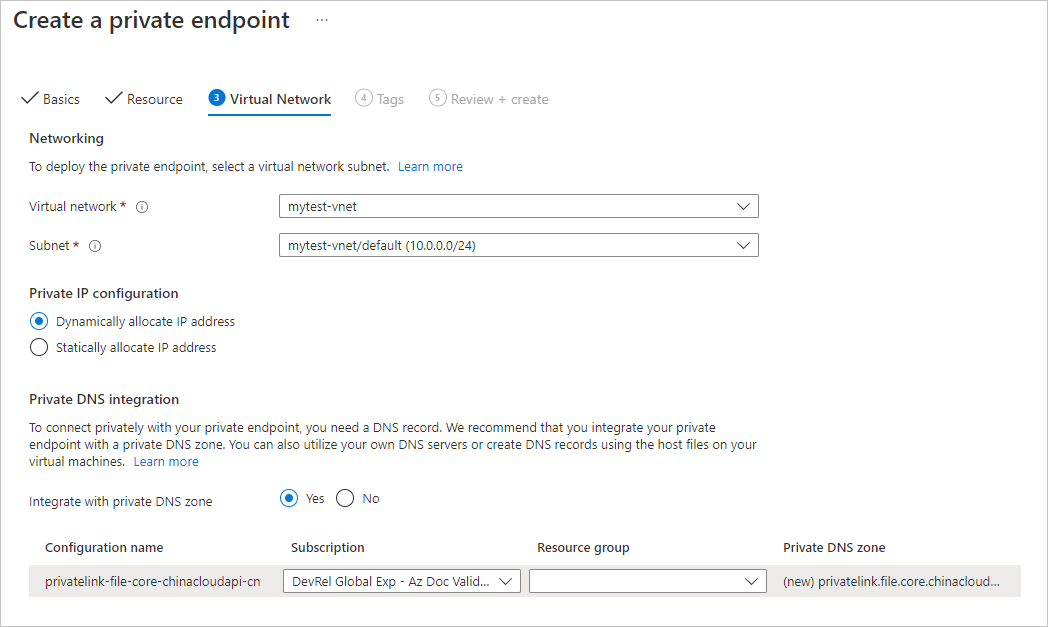
You can optionally apply tags to categorize your resources, such as applying the name Environment and the value Test to all testing resources. Enter name/value pairs if desired, and then select Next: Review + create.

Select Review + create to create the private endpoint.
If you have a VM inside of your virtual network, or you've configured DNS forwarding as described in Configuring DNS forwarding for Azure Files, you can test that your private endpoint is set up correctly by running the following commands from PowerShell, the command line, or the terminal (works for Windows, Linux, or macOS). You must replace <storage-account-name> with the appropriate storage account name:
nslookup <storage-account-name>.file.core.chinacloudapi.cn
If everything works successfully, you should see the following output, where 192.168.0.5 is the private IP address of the private endpoint in your virtual network (output shown for Windows):
Server: UnKnown
Address: 10.2.4.4
Non-authoritative answer:
Name: storageaccount.privatelink.file.core.chinacloudapi.cn
Address: 192.168.0.5
Aliases: storageaccount.file.core.chinacloudapi.cn
To create a private endpoint for your storage account, you first need to get a reference to your storage account and the virtual network subnet to which you want to add the private endpoint. Replace <storage-account-resource-group-name>, <storage-account-name>, <vnet-resource-group-name>, <vnet-name>, and <vnet-subnet-name> below:
$storageAccountResourceGroupName = "<storage-account-resource-group-name>"
$storageAccountName = "<storage-account-name>"
$virtualNetworkResourceGroupName = "<vnet-resource-group-name>"
$virtualNetworkName = "<vnet-name>"
$subnetName = "<vnet-subnet-name>"
# Get storage account reference, and throw error if it doesn't exist
$storageAccount = Get-AzStorageAccount `
-ResourceGroupName $storageAccountResourceGroupName `
-Name $storageAccountName `
-ErrorAction SilentlyContinue
if ($null -eq $storageAccount) {
$errorMessage = "Storage account $storageAccountName not found "
$errorMessage += "in resource group $storageAccountResourceGroupName."
Write-Error -Message $errorMessage -ErrorAction Stop
}
# Get virtual network reference, and throw error if it doesn't exist
$virtualNetwork = Get-AzVirtualNetwork `
-ResourceGroupName $virtualNetworkResourceGroupName `
-Name $virtualNetworkName `
-ErrorAction SilentlyContinue
if ($null -eq $virtualNetwork) {
$errorMessage = "Virtual network $virtualNetworkName not found "
$errorMessage += "in resource group $virtualNetworkResourceGroupName."
Write-Error -Message $errorMessage -ErrorAction Stop
}
# Get reference to virtual network subnet, and throw error if it doesn't exist
$subnet = $virtualNetwork | `
Select-Object -ExpandProperty Subnets | `
Where-Object { $_.Name -eq $subnetName }
if ($null -eq $subnet) {
Write-Error `
-Message "Subnet $subnetName not found in virtual network $virtualNetworkName." `
-ErrorAction Stop
}
To create a private endpoint, you must create a private link service connection to the storage account. The private link service connection is an input to the creation of the private endpoint.
# Disable private endpoint network policies
$subnet.PrivateEndpointNetworkPolicies = "Disabled"
$virtualNetwork = $virtualNetwork | `
Set-AzVirtualNetwork -ErrorAction Stop
# Create a private link service connection to the storage account.
$privateEndpointConnection = New-AzPrivateLinkServiceConnection `
-Name "$storageAccountName-Connection" `
-PrivateLinkServiceId $storageAccount.Id `
-GroupId "file" `
-ErrorAction Stop
# Create a new private endpoint.
$privateEndpoint = New-AzPrivateEndpoint `
-ResourceGroupName $storageAccountResourceGroupName `
-Name "$storageAccountName-PrivateEndpoint" `
-Location $virtualNetwork.Location `
-Subnet $subnet `
-PrivateLinkServiceConnection $privateEndpointConnection `
-ErrorAction Stop
Creating an Azure private DNS zone enables the original name of the storage account, such as storageaccount.file.core.chinacloudapi.cn to resolve to the private IP inside of the virtual network. Although optional from the perspective of creating a private endpoint, it is explicitly required for mounting the Azure file share directly using an AD user principal or accessing via the REST API.
# Get the desired storage account suffix (core.chinacloudapi.cn for Azure China cloud).
# This is done like this so this script will seamlessly work for non-public Azure.
$storageAccountSuffix = Get-AzContext | `
Select-Object -ExpandProperty Environment | `
Select-Object -ExpandProperty StorageEndpointSuffix
# For Azure China cloud, this will generate the following DNS suffix:
# privatelink.file.core.chinacloudapi.cn.
$dnsZoneName = "privatelink.file.$storageAccountSuffix"
# Find a DNS zone matching desired name attached to this virtual network.
$dnsZone = Get-AzPrivateDnsZone | `
Where-Object { $_.Name -eq $dnsZoneName } | `
Where-Object {
$privateDnsLink = Get-AzPrivateDnsVirtualNetworkLink `
-ResourceGroupName $_.ResourceGroupName `
-ZoneName $_.Name `
-ErrorAction SilentlyContinue
$privateDnsLink.VirtualNetworkId -eq $virtualNetwork.Id
}
if ($null -eq $dnsZone) {
# No matching DNS zone attached to virtual network, so create new one.
$dnsZone = New-AzPrivateDnsZone `
-ResourceGroupName $virtualNetworkResourceGroupName `
-Name $dnsZoneName `
-ErrorAction Stop
$privateDnsLink = New-AzPrivateDnsVirtualNetworkLink `
-ResourceGroupName $virtualNetworkResourceGroupName `
-ZoneName $dnsZoneName `
-Name "$virtualNetworkName-DnsLink" `
-VirtualNetworkId $virtualNetwork.Id `
-ErrorAction Stop
}
Now that you have a reference to the private DNS zone, you must create an A record for your storage account.
$privateEndpointIP = $privateEndpoint | `
Select-Object -ExpandProperty NetworkInterfaces | `
Select-Object @{
Name = "NetworkInterfaces";
Expression = { Get-AzNetworkInterface -ResourceId $_.Id }
} | `
Select-Object -ExpandProperty NetworkInterfaces | `
Select-Object -ExpandProperty IpConfigurations | `
Select-Object -ExpandProperty PrivateIpAddress
$privateDnsRecordConfig = New-AzPrivateDnsRecordConfig `
-IPv4Address $privateEndpointIP
New-AzPrivateDnsRecordSet `
-ResourceGroupName $virtualNetworkResourceGroupName `
-Name $storageAccountName `
-RecordType A `
-ZoneName $dnsZoneName `
-Ttl 600 `
-PrivateDnsRecords $privateDnsRecordConfig `
-ErrorAction Stop | `
Out-Null
If you have a VM inside of your virtual network, or you've configured DNS forwarding as described in Configuring DNS forwarding for Azure Files, you can test that your private endpoint is set up correctly with the following commands:
$storageAccountHostName = [System.Uri]::new($storageAccount.PrimaryEndpoints.file) | `
Select-Object -ExpandProperty Host
Resolve-DnsName -Name $storageAccountHostName
If everything works successfully, you should see the following output, where 192.168.0.5 is the private IP address of the private endpoint in your virtual network:
Name Type TTL Section NameHost
---- ---- --- ------- --------
storageaccount.file.core.chinacloudapi.cn CNAME 60 Answer storageaccount.privatelink.file.core.chinacloudapi.cn
Name : storageaccount.privatelink.file.core.chinacloudapi.cn
QueryType : A
TTL : 600
Section : Answer
IP4Address : 192.168.0.5
To create a private endpoint for your storage account, you first need to get a reference to your storage account and the virtual network subnet to which you want to add the private endpoint. Replace <storage-account-resource-group-name>, <storage-account-name>, <vnet-resource-group-name>, <vnet-name>, and <vnet-subnet-name> below:
storageAccountResourceGroupName="<storage-account-resource-group-name>"
storageAccountName="<storage-account-name>"
virtualNetworkResourceGroupName="<vnet-resource-group-name>"
virtualNetworkName="<vnet-name>"
subnetName="<vnet-subnet-name>"
# Get storage account ID
storageAccount=$(az storage account show \
--resource-group $storageAccountResourceGroupName \
--name $storageAccountName \
--query "id" | \
tr -d '"')
# Get virtual network ID
virtualNetwork=$(az network vnet show \
--resource-group $virtualNetworkResourceGroupName \
--name $virtualNetworkName \
--query "id" | \
tr -d '"')
# Get subnet ID
subnet=$(az network vnet subnet show \
--resource-group $virtualNetworkResourceGroupName \
--vnet-name $virtualNetworkName \
--name $subnetName \
--query "id" | \
tr -d '"')
To create a private endpoint, you must first ensure that the subnet's private endpoint network policy is set to disabled. Then you can create a private endpoint with the az network private-endpoint create command.
# Disable private endpoint network policies
az network vnet subnet update \
--ids $subnet \
--disable-private-endpoint-network-policies \
--output none
# Get virtual network location
region=$(az network vnet show \
--ids $virtualNetwork \
--query "location" | \
tr -d '"')
# Create a private endpoint
privateEndpoint=$(az network private-endpoint create \
--resource-group $storageAccountResourceGroupName \
--name "$storageAccountName-PrivateEndpoint" \
--location $region \
--subnet $subnet \
--private-connection-resource-id $storageAccount \
--group-id "file" \
--connection-name "$storageAccountName-Connection" \
--query "id" | \
tr -d '"')
Creating an Azure private DNS zone enables the original name of the storage account, such as storageaccount.file.core.chinacloudapi.cn to resolve to the private IP inside of the virtual network. Although optional from the perspective of creating a private endpoint, it is explicitly required for mounting the Azure file share using an AD user principal or accessing via the REST API.
# Get the desired storage account suffix (core.chinacloudapi.cn for Azure China cloud).
# This is done like this so this script will seamlessly work for non-public Azure.
storageAccountSuffix=$(az cloud show \
--query "suffixes.storageEndpoint" | \
tr -d '"')
# For Azure China cloud, this will generate the following DNS suffix:
# privatelink.file.core.chinacloudapi.cn.
dnsZoneName="privatelink.file.$storageAccountSuffix"
# Find a DNS zone matching desired name attached to this virtual network.
possibleDnsZones=""
possibleDnsZones=$(az network private-dns zone list \
--query "[?name == '$dnsZoneName'].id" \
--output tsv)
dnsZone=""
possibleDnsZone=""
for possibleDnsZone in $possibleDnsZones
do
possibleResourceGroupName=$(az resource show \
--ids $possibleDnsZone \
--query "resourceGroup" | \
tr -d '"')
link=$(az network private-dns link vnet list \
--resource-group $possibleResourceGroupName \
--zone-name $dnsZoneName \
--query "[?virtualNetwork.id == '$virtualNetwork'].id" \
--output tsv)
if [ -z $link ]
then
echo "1" > /dev/null
else
dnsZoneResourceGroup=$possibleResourceGroupName
dnsZone=$possibleDnsZone
break
fi
done
if [ -z $dnsZone ]
then
# No matching DNS zone attached to virtual network, so create a new one
dnsZone=$(az network private-dns zone create \
--resource-group $virtualNetworkResourceGroupName \
--name $dnsZoneName \
--query "id" | \
tr -d '"')
az network private-dns link vnet create \
--resource-group $virtualNetworkResourceGroupName \
--zone-name $dnsZoneName \
--name "$virtualNetworkName-DnsLink" \
--virtual-network $virtualNetwork \
--registration-enabled false \
--output none
dnsZoneResourceGroup=$virtualNetworkResourceGroupName
fi
Now that you have a reference to the private DNS zone, you must create an A record for your storage account.
privateEndpointNIC=$(az network private-endpoint show \
--ids $privateEndpoint \
--query "networkInterfaces[0].id" | \
tr -d '"')
privateEndpointIP=$(az network nic show \
--ids $privateEndpointNIC \
--query "ipConfigurations[0].privateIPAddress" | \
tr -d '"')
az network private-dns record-set a create \
--resource-group $dnsZoneResourceGroup \
--zone-name $dnsZoneName \
--name $storageAccountName \
--output none
az network private-dns record-set a add-record \
--resource-group $dnsZoneResourceGroup \
--zone-name $dnsZoneName \
--record-set-name $storageAccountName \
--ipv4-address $privateEndpointIP \
--output none
If you have a VM inside of your virtual network, or you've configured DNS forwarding as described in Configuring DNS forwarding for Azure Files, you can test that your private endpoint is set up correctly with the following commands:
httpEndpoint=$(az storage account show \
--resource-group $storageAccountResourceGroupName \
--name $storageAccountName \
--query "primaryEndpoints.file" | \
tr -d '"')
hostName=$(echo $httpEndpoint | cut -c7-$(expr length $httpEndpoint) | tr -d "/")
nslookup $hostName
If everything works successfully, you should see the following output, where 192.168.0.5 is the private IP address of the private endpoint in your virtual network:
Server: 127.0.0.53
Address: 127.0.0.53#53
Non-authoritative answer:
storageaccount.file.core.chinacloudapi.cn canonical name = storageaccount.privatelink.file.core.chinacloudapi.cn.
Name: storageaccount.privatelink.file.core.chinacloudapi.cn
Address: 192.168.0.5
Create the Storage Sync Service private endpoint
Navigate to the Private Link Center by typing Private Link into the search bar at the top of the Azure portal. In the table of contents for the Private Link Center, select Private endpoints, and then + Add to create a new private endpoint.
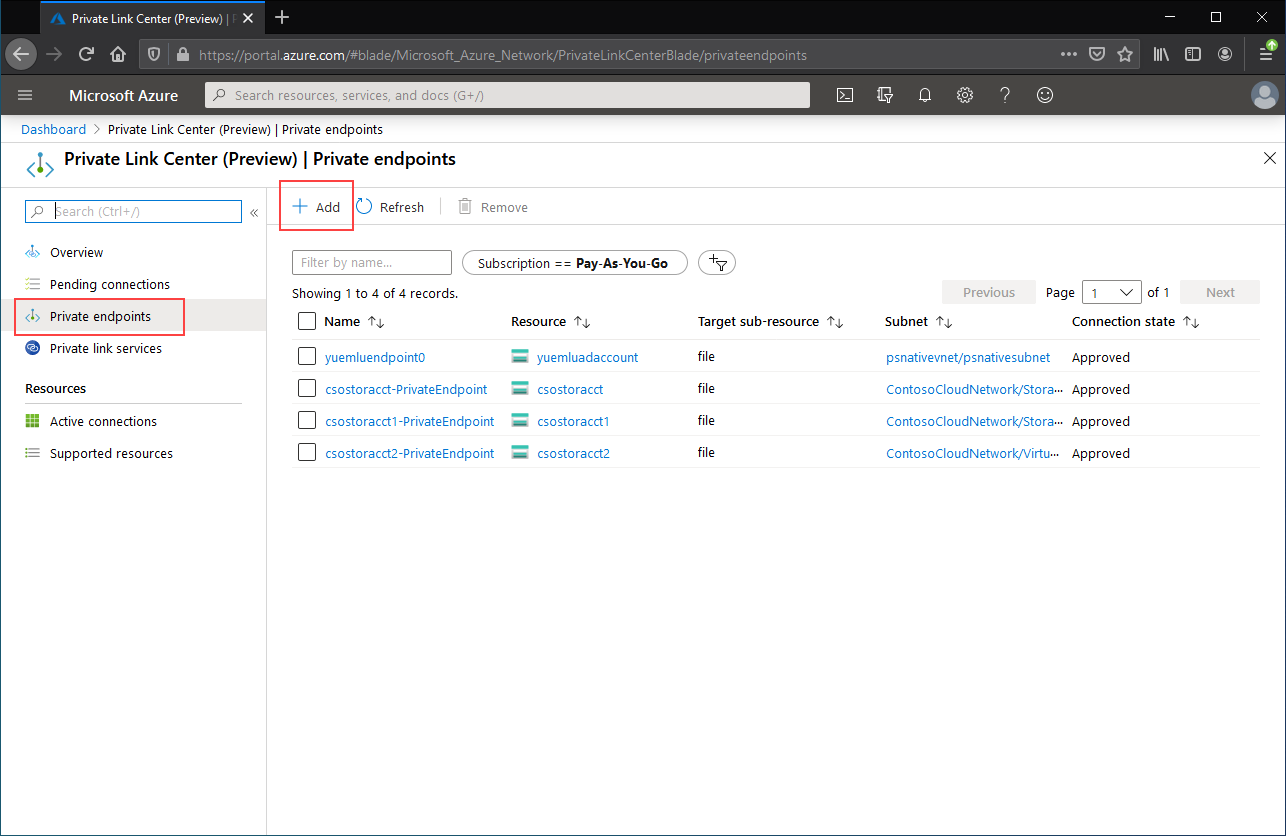
The resulting wizard has multiple pages to complete.
In the Basics blade, select the desired resource group, name, and region for your private endpoint. These can be whatever you want, they don't have to match the Storage Sync Service in any way, although you must create the private endpoint in the same region as the virtual network you wish to create the private endpoint in.
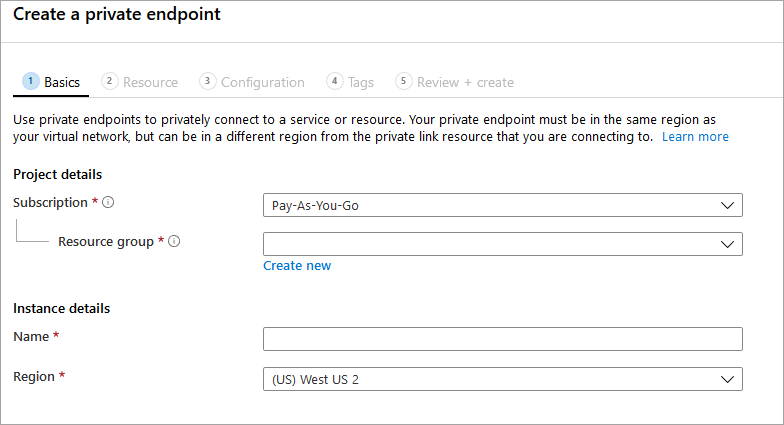
In the Resource blade, select the radio button for Connect to an Azure resource in my directory. Under the Resource type, select Microsoft.StorageSync/storageSyncServices for the resource type.
The Configuration blade allows you to select the specific virtual network and subnet you would like to add your private endpoint to. Select the same virtual network as the one you used for the storage account above. The Configuration blade also contains the information for creating/updating the private DNS zone.
Select Review + create to create the private endpoint.
You can test that your private endpoint is set up correctly by running the following PowerShell commands.
$privateEndpointResourceGroupName = "<your-private-endpoint-resource-group>"
$privateEndpointName = "<your-private-endpoint-name>"
Get-AzPrivateEndpoint `
-ResourceGroupName $privateEndpointResourceGroupName `
-Name $privateEndpointName `
-ErrorAction Stop | `
Select-Object -ExpandProperty NetworkInterfaces | `
Select-Object -ExpandProperty Id | `
ForEach-Object { Get-AzNetworkInterface -ResourceId $_ } | `
Select-Object -ExpandProperty IpConfigurations | `
Select-Object -ExpandProperty PrivateLinkConnectionProperties | `
Select-Object -ExpandProperty Fqdns | `
ForEach-Object { Resolve-DnsName -Name $_ } | `
Format-List
If everything works correctly, you should see the following output where 192.168.1.4, 192.168.1.5, 192.168.1.6, and 192.168.1.7 are the private IP addresses assigned to the private endpoint:
Name : mysssmanagement.chinaeast2.afs.azure.cn
Type : CNAME
TTL : 60
Section : Answer
NameHost : mysssmanagement.chinaeast2.privatelink.afs.azure.cn
Name : mysssmanagement.chinaeast2.privatelink.afs.azure.cn
QueryType : A
TTL : 60
Section : Answer
IP4Address : 192.168.1.4
Name : myssssyncp.chinaeast2.afs.azure.cn
Type : CNAME
TTL : 60
Section : Answer
NameHost : myssssyncp.chinaeast2.privatelink.afs.azure.cn
Name : myssssyncp.chinaeast2.privatelink.afs.azure.cn
QueryType : A
TTL : 60
Section : Answer
IP4Address : 192.168.1.5
Name : myssssyncs.chinaeast2.afs.azure.cn
Type : CNAME
TTL : 60
Section : Answer
NameHost : myssssyncs.chinaeast2.privatelink.afs.azure.cn
Name : myssssyncs.chinaeast2.privatelink.afs.azure.cn
QueryType : A
TTL : 60
Section : Answer
IP4Address : 192.168.1.6
Name : mysssmonitoring.chinaeast2.afs.azure.cn
Type : CNAME
TTL : 60
Section : Answer
NameHost : mysssmonitoring.chinaeast2.privatelink.afs.azure.cn
Name : mysssmonitoring.chinaeast2.privatelink.afs.azure.cn
QueryType : A
TTL : 60
Section : Answer
IP4Address : 192.168.1.7
To create a private endpoint for your Storage Sync Service, first you'll need to get a reference to your Storage Sync Service. Remember to replace <storage-sync-service-resource-group> and <storage-sync-service> with the correct values for your environment. The following PowerShell commands assume that you've already populated the virtual network information.
$storageSyncServiceResourceGroupName = "<storage-sync-service-resource-group>"
$storageSyncServiceName = "<storage-sync-service>"
$storageSyncService = Get-AzStorageSyncService `
-ResourceGroupName $storageSyncServiceResourceGroupName `
-Name $storageSyncServiceName `
-ErrorAction SilentlyContinue
if ($null -eq $storageSyncService) {
$errorMessage = "Storage Sync Service $storageSyncServiceName not found "
$errorMessage += "in resource group $storageSyncServiceResourceGroupName."
Write-Error -Message $errorMessage -ErrorAction Stop
}
To create a private endpoint, you must create a private link service connection to the Storage Sync Service. The private link connection is an input to the creation of the private endpoint.
# Disable private endpoint network policies
$subnet.PrivateEndpointNetworkPolicies = "Disabled"
$virtualNetwork = $virtualNetwork | `
Set-AzVirtualNetwork -ErrorAction Stop
# Create a private link service connection to the storage account.
$privateEndpointConnection = New-AzPrivateLinkServiceConnection `
-Name "$storageSyncServiceName-Connection" `
-PrivateLinkServiceId $storageSyncService.ResourceId `
-GroupId "Afs" `
-ErrorAction Stop
# Create a new private endpoint.
$privateEndpoint = New-AzPrivateEndpoint `
-ResourceGroupName $storageSyncServiceResourceGroupName `
-Name "$storageSyncServiceName-PrivateEndpoint" `
-Location $virtualNetwork.Location `
-Subnet $subnet `
-PrivateLinkServiceConnection $privateEndpointConnection `
-ErrorAction Stop
Creating an Azure private DNS zone enables the host names for the Storage Sync Service, such as mysssmanagement.chinaeast2.afs.azure.cn, to resolve to the correct private IPs for the Storage Sync Service inside of the virtual network. Although optional from the perspective of creating a private endpoint, it's explicitly required for the Azure File Sync agent to access the Storage Sync Service.
# For China cloud, this will generate the following DNS suffix:
# privatelink.afs.azure.cn
$storageSyncSuffix = "afs.azure.cn"
$dnsZoneName = "privatelink.$storageSyncSuffix"
# Find a DNS zone matching desired name attached to this virtual network.
$dnsZone = Get-AzPrivateDnsZone | `
Where-Object { $_.Name -eq $dnsZoneName } | `
Where-Object {
$privateDnsLink = Get-AzPrivateDnsVirtualNetworkLink `
-ResourceGroupName $_.ResourceGroupName `
-ZoneName $_.Name `
-ErrorAction SilentlyContinue
$privateDnsLink.VirtualNetworkId -eq $virtualNetwork.Id
}
if ($null -eq $dnsZone) {
# No matching DNS zone attached to virtual network, so create new one.
$dnsZone = New-AzPrivateDnsZone `
-ResourceGroupName $virtualNetworkResourceGroupName `
-Name $dnsZoneName `
-ErrorAction Stop
$privateDnsLink = New-AzPrivateDnsVirtualNetworkLink `
-ResourceGroupName $virtualNetworkResourceGroupName `
-ZoneName $dnsZoneName `
-Name "$virtualNetworkName-DnsLink" `
-VirtualNetworkId $virtualNetwork.Id `
-ErrorAction Stop
}
Now that you have a reference to the private DNS zone, you must create an A record for your Storage Sync Service.
$privateEndpointIpFqdnMappings = $privateEndpoint | `
Select-Object -ExpandProperty NetworkInterfaces | `
Select-Object -ExpandProperty Id | `
ForEach-Object { Get-AzNetworkInterface -ResourceId $_ } | `
Select-Object -ExpandProperty IpConfigurations | `
ForEach-Object {
$privateIpAddress = $_.PrivateIpAddress;
$_ | `
Select-Object -ExpandProperty PrivateLinkConnectionProperties | `
Select-Object -ExpandProperty Fqdns | `
Select-Object `
@{
Name = "PrivateIpAddress";
Expression = { $privateIpAddress }
}, `
@{
Name = "FQDN";
Expression = { $_ }
}
}
foreach($ipFqdn in $privateEndpointIpFqdnMappings) {
$privateDnsRecordConfig = New-AzPrivateDnsRecordConfig `
-IPv4Address $ipFqdn.PrivateIpAddress
$dnsEntry = $ipFqdn.FQDN.Substring(0,
$ipFqdn.FQDN.IndexOf(".", $ipFqdn.FQDN.IndexOf(".") + 1))
New-AzPrivateDnsRecordSet `
-ResourceGroupName $virtualNetworkResourceGroupName `
-Name $dnsEntry `
-RecordType A `
-ZoneName $dnsZoneName `
-Ttl 600 `
-PrivateDnsRecords $privateDnsRecordConfig `
-ErrorAction Stop | `
Out-Null
}
To create a private endpoint for your Storage Sync Service, first you'll need to get a reference to your Storage Sync Service. Remember to replace <storage-sync-service-resource-group> and <storage-sync-service> with the correct values for your environment. The following CLI commands assume that you've already populated the virtual network information.
storageSyncServiceResourceGroupName="<storage-sync-service-resource-group>"
storageSyncServiceName="<storage-sync-service>"
storageSyncService=$(az resource show \
--resource-group $storageSyncServiceResourceGroupName \
--name $storageSyncServiceName \
--resource-type "Microsoft.StorageSync/storageSyncServices" \
--query "id" | \
tr -d '"')
storageSyncServiceRegion=$(az resource show \
--resource-group $storageSyncServiceResourceGroupName \
--name $storageSyncServiceName \
--resource-type "Microsoft.StorageSync/storageSyncServices" \
--query "location" | \
tr -d '"')
To create a private endpoint, you must first ensure that the subnet's private endpoint network policy is set to disabled. Then you can create a private endpoint with the az network private-endpoint create command.
# Disable private endpoint network policies
az network vnet subnet update \
--ids $subnet \
--disable-private-endpoint-network-policies \
--output none
# Get virtual network location
region=$(az network vnet show \
--ids $virtualNetwork \
--query "location" | \
tr -d '"')
# Create a private endpoint
privateEndpoint=$(az network private-endpoint create \
--resource-group $storageSyncServiceResourceGroupName \
--name "$storageSyncServiceName-PrivateEndpoint" \
--location $region \
--subnet $subnet \
--private-connection-resource-id $storageSyncService \
--group-id "Afs" \
--connection-name "$storageSyncServiceName-Connection" \
--query "id" | \
tr -d '"')
Creating an Azure private DNS zone enables the host names for the Storage Sync Service, such as mysssmanagement.chinaeast2.afs.azure.cn, to resolve to the correct private IPs for the Storage Sync Service inside of the virtual network. Although optional from the perspective of creating a private endpoint, it is explicitly required for the Azure File Sync agent to access the Storage Sync Service.
# For China cloud, this will generate the following DNS suffix:
# privatelinke.afs.azure.cn.
storageSyncSuffix="afs.azure.cn"
dnsZoneName="privatelink.$storageSyncSuffix"
# Find a DNS zone matching desired name attached to this virtual network.
possibleDnsZones=""
possibleDnsZones=$(az network private-dns zone list \
--query "[?name == '$dnsZoneName'].id" \
--output tsv)
dnsZone=""
possibleDnsZone=""
for possibleDnsZone in $possibleDnsZones
do
possibleResourceGroupName=$(az resource show \
--ids $possibleDnsZone \
--query "resourceGroup" | \
tr -d '"')
link=$(az network private-dns link vnet list \
--resource-group $possibleResourceGroupName \
--zone-name $dnsZoneName \
--query "[?virtualNetwork.id == '$virtualNetwork'].id" \
--output tsv)
if [ -z $link ]
then
echo "1" > /dev/null
else
dnsZoneResourceGroup=$possibleResourceGroupName
dnsZone=$possibleDnsZone
break
fi
done
if [ -z $dnsZone ]
then
# No matching DNS zone attached to virtual network, so create a new one
dnsZone=$(az network private-dns zone create \
--resource-group $virtualNetworkResourceGroupName \
--name $dnsZoneName \
--query "id" | \
tr -d '"')
az network private-dns link vnet create \
--resource-group $virtualNetworkResourceGroupName \
--zone-name $dnsZoneName \
--name "$virtualNetworkName-DnsLink" \
--virtual-network $virtualNetwork \
--registration-enabled false \
--output none
dnsZoneResourceGroup=$virtualNetworkResourceGroupName
fi
Now that you have a reference to the private DNS zone, you must create an A record for your Storage Sync Service.
privateEndpointNIC=$(az network private-endpoint show \
--ids $privateEndpoint \
--query "networkInterfaces[0].id" | \
tr -d '"')
privateIpAddresses=$(az network nic show \
--ids $privateEndpointNIC \
--query "ipConfigurations[].privateIpAddress" \
--output tsv)
hostNames=$(az network nic show \
--ids $privateEndpointNIC \
--query "ipConfigurations[].privateLinkConnectionProperties.fqdns[]" \
--output tsv)
i=0
for privateIpAddress in $privateIpAddresses
do
j=0
targetHostName=""
for hostName in $hostNames
do
if [ $i == $j ]
then
targetHostName=$hostName
break
fi
j=$(expr $j + 1)
done
endpointName=$(echo $targetHostName | \
cut -c1-$(expr $(expr index $targetHostName ".") - 1))
az network private-dns record-set a create \
--resource-group $dnsZoneResourceGroup \
--zone-name $dnsZoneName \
--name "$endpointName.$storageSyncServiceRegion" \
--output none
az network private-dns record-set a add-record \
--resource-group $dnsZoneResourceGroup \
--zone-name $dnsZoneName \
--record-set-name "$endpointName.$storageSyncServiceRegion" \
--ipv4-address $privateIpAddress \
--output none
i=$(expr $i + 1)
done
Restrict access to the public endpoints
You can restrict access to the public endpoints of both the storage account and the Storage Sync Services. Restricting access to the public endpoint provides additional security by ensuring that network packets are only accepted from approved locations.
Restrict access to the storage account public endpoint
Access restriction to the public endpoint is done using the storage account firewall settings. In general, most firewall policies for a storage account will restrict networking access to one or more virtual networks. There are two approaches to restricting access to a storage account to a virtual network:
- Create one or more private endpoints for the storage account and disable access to the public endpoint. This ensures that only traffic originating from within the desired virtual networks can access the Azure file shares within the storage account.
- Restrict the public endpoint to one or more virtual networks. This works by using a capability of the virtual network called service endpoints. When you restrict the traffic to a storage account via a service endpoint, you're still accessing the storage account via the public IP address.
Note
The Allow Azure services on the trusted services list to access this storage account exception must be selected on your storage account to allow trusted first party Azure services such as Azure File Sync to access the storage account. To learn more, see Grant access to trusted Azure services.
Grant access to trusted Azure services and disable access to the storage account public endpoint
When access to the public endpoint is disabled, the storage account can still be accessed through its private endpoints. Otherwise valid requests to the storage account's public endpoint will be rejected.
Navigate to the storage account for which you would like to restrict all access to the public endpoint. In the table of contents for the storage account, select Networking.
At the top of the page, select the Enabled from selected virtual networks and IP addresses radio button. This will un-hide a number of settings for controlling the restriction of the public endpoint. Select Allow Azure services on the trusted services list to access this storage account to allow trusted first party Microsoft services such as Azure File Sync to access the storage account.
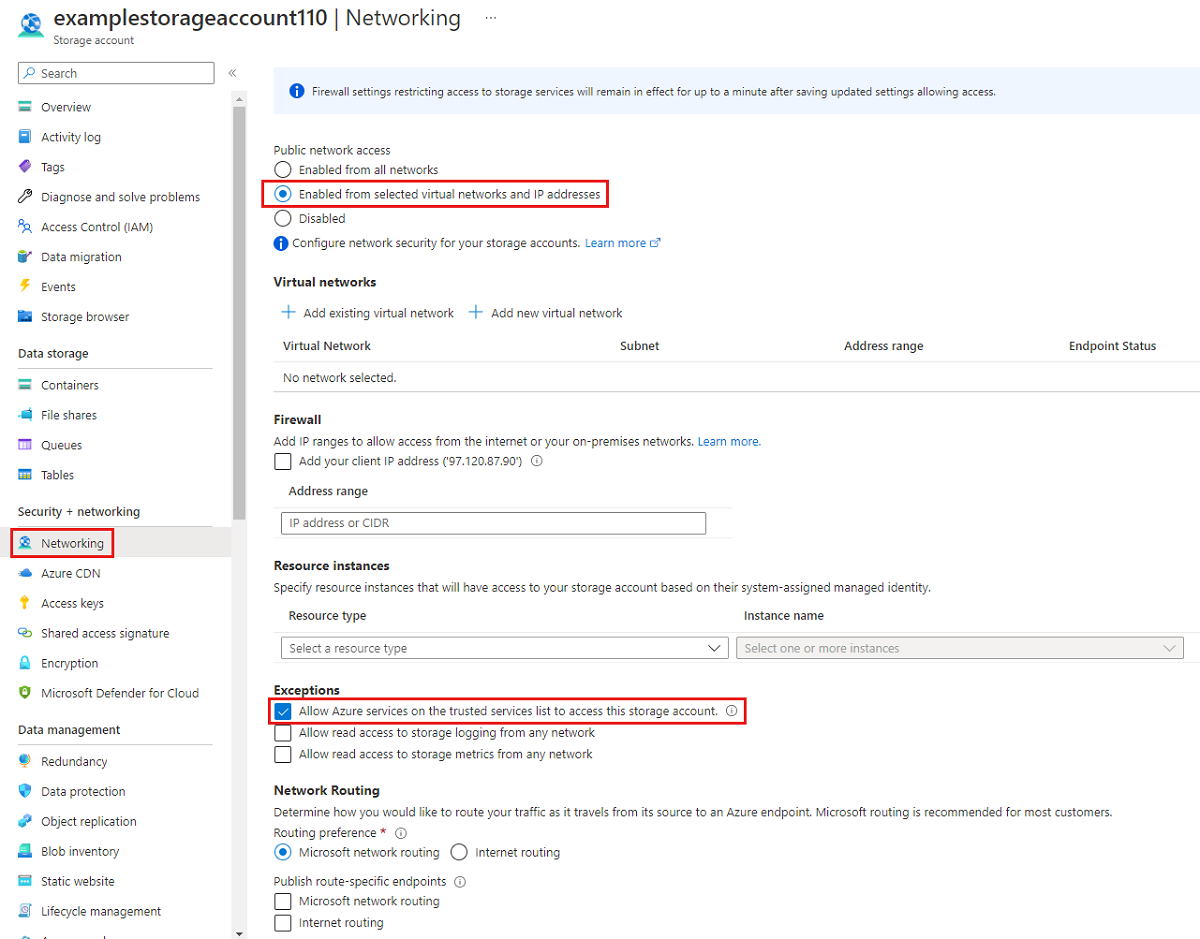
The following PowerShell command will deny all traffic to the storage account's public endpoint. Note that this command has the -Bypass parameter set to AzureServices. This will allow trusted first party services such as Azure File Sync to access the storage account via the public endpoint.
# This assumes $storageAccount is still defined from the beginning of this of this guide.
$storageAccount | Update-AzStorageAccountNetworkRuleSet `
-DefaultAction Deny `
-Bypass AzureServices `
-WarningAction SilentlyContinue `
-ErrorAction Stop | `
Out-Null
The following CLI command will deny all traffic to the storage account's public endpoint. Note that this command has the -bypass parameter set to AzureServices. This will allow trusted first party services such as Azure File Sync to access the storage account via the public endpoint.
# This assumes $storageAccountResourceGroupName and $storageAccountName
# are still defined from the beginning of this guide.
az storage account update \
--resource-group $storageAccountResourceGroupName \
--name $storageAccountName \
--bypass "AzureServices" \
--default-action "Deny" \
--output none
Grant access to trusted Azure services and restrict access to the storage account public endpoint to specific virtual networks
When you restrict the storage account to specific virtual networks, you're allowing requests to the public endpoint from within the specified virtual networks. This works by using a capability of the virtual network called service endpoints. This can be used with or without private endpoints.
Navigate to the storage account for which you would like to restrict the public endpoint to specific virtual networks. In the table of contents for the storage account, select Networking.
At the top of the page, select the Enabled from selected virtual networks and IP addresses radio button. This will un-hide a number of settings for controlling the restriction of the public endpoint. Select +Add existing virtual network to select the specific virtual network that should be allowed to access the storage account via the public endpoint. Select a virtual network and a subnet for that virtual network, and then select Enable.
Select Allow Azure services on the trusted services list to access this storage account to allow trusted first party Microsoft services such as Azure File Sync to access the storage account.
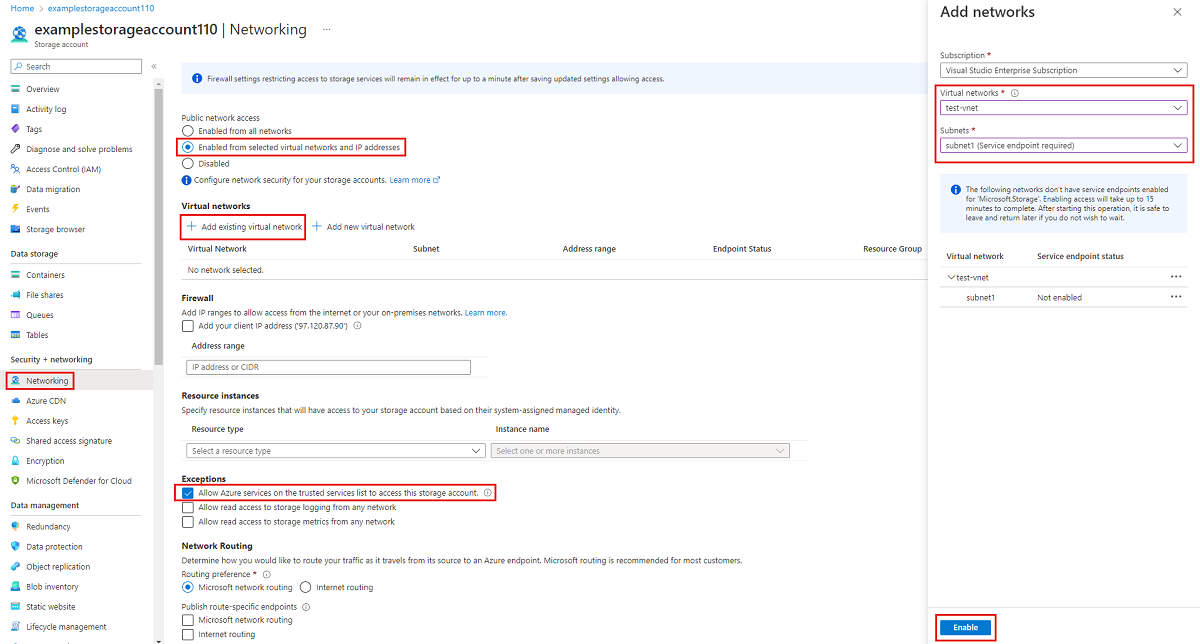
To restrict access to the storage account's public endpoint to specific virtual networks using service endpoints, we first need to collect information about the storage account and virtual network. Fill in <storage-account-resource-group>, <storage-account-name>, <vnet-resource-group-name>, <vnet-name>, and <subnet-name> to collect this information.
$storageAccountResourceGroupName = "<storage-account-resource-group>"
$storageAccountName = "<storage-account-name>"
$restrictToVirtualNetworkResourceGroupName = "<vnet-resource-group-name>"
$restrictToVirtualNetworkName = "<vnet-name>"
$subnetName = "<subnet-name>"
$storageAccount = Get-AzStorageAccount `
-ResourceGroupName $storageAccountResourceGroupName `
-Name $storageAccountName `
-ErrorAction Stop
$virtualNetwork = Get-AzVirtualNetwork `
-ResourceGroupName $restrictToVirtualNetworkResourceGroupName `
-Name $restrictToVirtualNetworkName `
-ErrorAction Stop
$subnet = $virtualNetwork | `
Select-Object -ExpandProperty Subnets | `
Where-Object { $_.Name -eq $subnetName }
if ($null -eq $subnet) {
Write-Error `
-Message "Subnet $subnetName not found in virtual network $restrictToVirtualNetworkName." `
-ErrorAction Stop
}
In order for traffic from the virtual network to be allowed by the Azure network fabric to get to the storage account public endpoint, the virtual network's subnet must have the Microsoft.Storage service endpoint exposed. The following PowerShell commands will add the Microsoft.Storage service endpoint to the subnet if it's not already there.
$serviceEndpoints = $subnet | `
Select-Object -ExpandProperty ServiceEndpoints | `
Select-Object -ExpandProperty Service
if ($serviceEndpoints -notcontains "Microsoft.Storage") {
if ($null -eq $serviceEndpoints) {
$serviceEndpoints = @("Microsoft.Storage")
} elseif ($serviceEndpoints -is [string]) {
$serviceEndpoints = @($serviceEndpoints, "Microsoft.Storage")
} else {
$serviceEndpoints += "Microsoft.Storage"
}
$virtualNetwork = $virtualNetwork | Set-AzVirtualNetworkSubnetConfig `
-Name $subnetName `
-AddressPrefix $subnet.AddressPrefix `
-ServiceEndpoint $serviceEndpoints `
-WarningAction SilentlyContinue `
-ErrorAction Stop | `
Set-AzVirtualNetwork `
-ErrorAction Stop
}
The final step in restricting traffic to the storage account is to create a networking rule and add to the storage account's network rule set.
$networkRule = $storageAccount | Add-AzStorageAccountNetworkRule `
-VirtualNetworkResourceId $subnet.Id `
-ErrorAction Stop
$storageAccount | Update-AzStorageAccountNetworkRuleSet `
-DefaultAction Deny `
-Bypass AzureServices `
-VirtualNetworkRule $networkRule `
-WarningAction SilentlyContinue `
-ErrorAction Stop | `
Out-Null
To restrict access to the storage account's public endpoint to specific virtual networks using service endpoints, we first need to collect information about the storage account and virtual network. Fill in <storage-account-resource-group>, <storage-account-name>, <vnet-resource-group-name>, <vnet-name>, and <subnet-name> to collect this information.
storageAccountResourceGroupName="<storage-account-resource-group>"
storageAccountName="<storage-account-name>"
restrictToVirtualNetworkResourceGroupName="<vnet-resource-group-name>"
restrictToVirtualNetworkName="<vnet-name>"
subnetName="<subnet-name>"
storageAccount=$(az storage account show \
--resource-group $storageAccountResourceGroupName \
--name $storageAccountName \
--query "id" | \
tr -d '"')
virtualNetwork=$(az network vnet show \
--resource-group $restrictToVirtualNetworkResourceGroupName \
--name $restrictToVirtualNetworkName \
--query "id" | \
tr -d '"')
subnet=$(az network vnet subnet show \
--resource-group $restrictToVirtualNetworkResourceGroupName \
--vnet-name $restrictToVirtualNetworkName \
--name $subnetName \
--query "id" | \
tr -d '"')
In order for traffic from the virtual network to be allowed by the Azure network fabric to get to the storage account public endpoint, the virtual network's subnet must have the Microsoft.Storage service endpoint exposed. The following CLI commands will add the Microsoft.Storage service endpoint to the subnet if it's not already there.
serviceEndpoints=$(az network vnet subnet show \
--resource-group $restrictToVirtualNetworkResourceGroupName \
--vnet-name $restrictToVirtualNetworkName \
--name $subnetName \
--query "serviceEndpoints[].service" \
--output tsv)
foundStorageServiceEndpoint=false
for serviceEndpoint in $serviceEndpoints
do
if [ $serviceEndpoint = "Microsoft.Storage" ]
then
foundStorageServiceEndpoint=true
fi
done
if [ $foundStorageServiceEndpoint = false ]
then
serviceEndpointList=""
for serviceEndpoint in $serviceEndpoints
do
serviceEndpointList+=$serviceEndpoint
serviceEndpointList+=" "
done
serviceEndpointList+="Microsoft.Storage"
az network vnet subnet update \
--ids $subnet \
--service-endpoints $serviceEndpointList \
--output none
fi
The final step in restricting traffic to the storage account is to create a networking rule and add to the storage account's network rule set.
az storage account network-rule add \
--resource-group $storageAccountResourceGroupName \
--account-name $storageAccountName \
--subnet $subnet \
--output none
az storage account update \
--resource-group $storageAccountResourceGroupName \
--name $storageAccountName \
--bypass "AzureServices" \
--default-action "Deny" \
--output none
Disable access to the Storage Sync Service public endpoint
Azure File Sync enables you to restrict access to specific virtual networks through private endpoints only; Azure File Sync doesn't support service endpoints for restricting access to the public endpoint to specific virtual networks. This means that the two states for the Storage Sync Service's public endpoint are enabled and disabled.
Important
You must create a private endpoint before disabling access to the public endpoint. If the public endpoint is disabled and there's no private endpoint configured, sync can't work.
To disable access to the Storage Sync Service's public endpoint, follow these steps:
- Sign in to the Azure portal.
- Navigate to the Storage Sync Service and select Settings > Network from the left navigation.
- Under Allow access from, select Private endpoints only.
- Select a private endpoint from the Private endpoint connections list.
To disable access to the Storage Sync Service's public endpoint, set the incomingTrafficPolicy property on the Storage Sync Service to AllowVirtualNetworksOnly. If you want to enable access to the Storage Sync Service's public endpoint, set incomingTrafficPolicy to AllowAllTraffic instead. Remember to replace <storage-sync-service-resource-group> and <storage-sync-service> with your own values.
$storageSyncServiceResourceGroupName = "<storage-sync-service-resource-group>"
$storageSyncServiceName = "<storage-sync-service>"
Set-AzStorageSyncService `
-ResourceGroupName $storageSyncServiceResourceGroupName `
-Name $storageSyncServiceName `
-IncomingTrafficPolicy AllowVirtualNetworksOnly
Azure CLI doesn't support setting the incomingTrafficPolicy property on the Storage Sync Service. Please select the Azure PowerShell tab to get instructions on how to disable the Storage Sync Service public endpoint.
Azure Policy
Azure Policy helps enforce organization standards and assess compliance against those standards at scale. Azure Files and Azure File Sync expose several useful audit and remediation network policies that help you monitor and automate your deployment.
Policies audit your environment and alert you if your storage accounts or Storage Sync Services diverge from the defined behavior. For example, if a public endpoint is enabled when your policy was set to have the public endpoints disabled. Modify/deploy policies take things a step further and proactively modify a resource (such as the Storage Sync Service) or deploy resources (such as private endpoints) to align with the policies.
The following pre-defined policies are available for Azure Files and Azure File Sync:
| Action |
Service |
Condition |
Policy name |
| Audit |
Azure Files |
The storage account's public endpoint is enabled. See Grant access to trusted Azure services and disable access to the storage account public endpoint for more information. |
Storage accounts should restrict network access |
| Audit |
Azure File Sync |
The Storage Sync Service's public endpoint is enabled. See Disable access to the Storage Sync Service public endpoint for more information. |
Public network access should be disabled for Azure File Sync |
| Audit |
Azure Files |
The storage account needs at least one private endpoint. See Create the storage account private endpoint for more information. |
Storage account should use a private link connection |
| Audit |
Azure File Sync |
The Storage Sync Service needs at least one private endpoint. See Create the Storage Sync Service private endpoint for more information. |
Azure File Sync should use private link |
| Modify |
Azure File Sync |
Disable the Storage Sync Service's public endpoint. |
Modify - Configure Azure File Sync to disable public network access |
| Deploy |
Azure File Sync |
Deploy a private endpoint for the Storage Sync Service. |
Configure Azure File Sync with private endpoints |
| Deploy |
Azure File Sync |
Deploy an A record to privatelink.afs.azure.net DNS zone. |
Configure Azure File Sync to use private DNS zones |
Set up a private endpoint deployment policy
To set up a private endpoint deployment policy, go to the Azure portal, and search for Policy. The Azure Policy center should be a top result. Navigate to Authoring > Definitions in the Policy center's table of contents. The resulting Definitions pane contains the pre-defined policies across all Azure services. To find the specific policy, select the Storage category in the category filter, or search for Configure Azure File Sync with private endpoints. Select ... and Assign to create a new policy from the definition.
The Basics blade of the Assign policy wizard enables you to set a scope, resource or resource group exclusion list, and to give your policy a friendly name to help you distinguish it. You don't need to modify these for the policy to work, but you can if you want to make modifications. Select Next to advance to the Parameters page.
On the Parameters blade, select the ... next to the privateEndpointSubnetId drop down list to select the virtual network and subnet where the private endpoints for your Storage Sync Service resources should be deployed. The resulting wizard may take several seconds to load the available virtual networks in your subscription. Select the appropriate virtual network/subnet for your environment and click Select. Select Next to advance to the Remediation blade.
In order for the private endpoint to be deployed when a Storage Sync Service without a private endpoint is identified, you must select the Create a remediation task on the Remediation page. Finally, select Review + create to review the policy assignment and Create to create it.
The resulting policy assignment will be executed on a periodic basis and might not run immediately after being created.
See also








